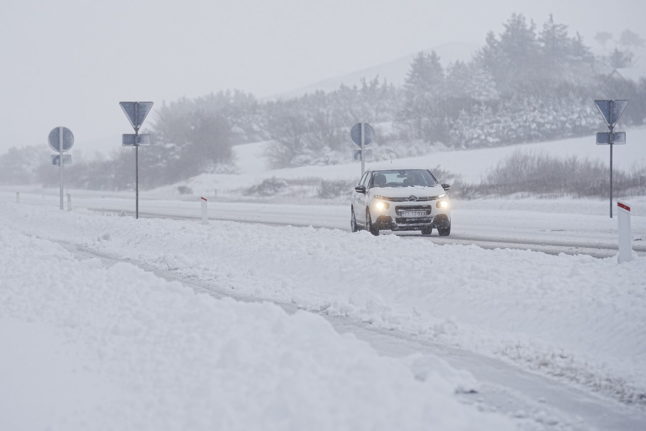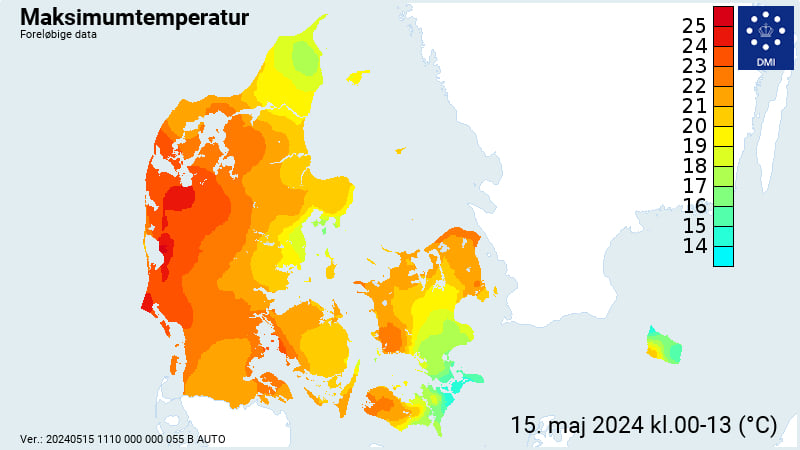TV2 reported that as much as 28cm of snow had been recorded in Thisted, northwestern Jutland with more than 20cm falling across much of northern Jutland. The Danish Meteorological Institute reported that between 5cm-10cm of snow had fallen north of the Limfjord, 5cm around Ringkøbing and Aarhus, and lower amounts elsewhere.
Klaus Larson, a meteorologist at the Danish Meteorological Institute told Ritzau on Tuesday morning that people in the north of Jutland would see even more snow over the rest of Tuesday.
“It is still expected that 10cm-15cm, and maybe even 20cm, could fall north of the Limfjord,” he said.
Rail
The snow caused several faults on the stretch of rail between the north Jutland city of Aalborg and Aalborg airport, forcing Denmark’s national rail operator DSB to cancel all departures on the route on Tuesday. The cancellations were announced in a tweet on Tuesday morning, with passengers advised to take city buses instead.
DSB also warned on Tuesday morning that S-banen commuter trains in Copenhagen could be affected by strong winds expected to hit from 12pm.
“Traffic on the S-banen could be affected by strong winds. We are following the situation closely and will provide frequent updates,” DSB wrote on its home page, advising travellers to check the Rejseplanen.dk app before travelling, and to consider travelling earlier in the morning.
This came after the rail operator on Monday night announced the cancellation of several services between Aarhus and Aalborg on Tuesday as a result of the expected snow storms in central and northern parts of Jutland.
The cancelled rail services are the faster Intercity Lyntog trains, DSB said. The slower Intercity service will continue to run.
The affected route connects Aalborg Airport to Copenhagen Airport, meaning the part of the service between Aarhus and Aalborg Airport will not run, but trains will still operate as normal between Aarhus and Copenhagen.
DMI varsler snestorm i aften til tirsdag eftermiddag 7. marts. Foreløbig ændringer i fra imorgen:
Aarhus H-Aalborg Lufthavn: ICL-tog (Cph Lufthavn-Aalborg Lufthavn) er aflyst ml. Aarhus H-Aalborg Lufthavn.
Der kan komme yderligere ændringer. Læs mere her: https://t.co/4AVNUQD0Kg pic.twitter.com/QKV8PYwRov— DSB (@omDSB) March 6, 2023
“[Track operator] Banedanmark and DSB are following the situation closely and have an ongoing dialogue with DMI,” DSB wrote on its website.
Strong winds, possibly up to gale force, are also forecast for late Monday and Tuesday morning, meaning further rail disruptions are possible, and that other parts of Denmark could also be affected.
Passengers are advised to check journey details for any changes via the Rejseplanen app or website.
READ ALSO: 17 essential phone apps to make your life in Denmark easier
In addition to the link with Aarhus, local rail services are also disrupted in North Jutland.
Local public transport operator NT, which runs regional trains, said that services on Tuesday will follow the timetable normally used on Sundays, meaning departures are reduced to one per hour.
Buses in the region could also be affected.
On the company’s website, customers are advised to check the routes, either on their home page or on the rejseplanen.dk app.

Road travel
The poor weather has caused several accidents on Tuesday morning, leading to traffic jams. There was an accident on the Vestmotorvejen (E20) at Sorø in the direction of Funen, at around 7am, and an accident on the Sydmotorvejen (E47) northbound at Bregentved.
The Great Belt Bridge closed to wind-sensitive vehicles due to the strong winds between 2:45am and 5am and then from 7am to 8.52am. The bridge’s operator Sund & Bælt is announcing updates on Twitter.
Light and wind-sensitive vehicles are also advised not to drive over the Langelandsbroen bridge on Tuesday morning.
The Øresunds Bridge is not currently expected to close, but the bridge’s operator advises travellers to check before departing.
Fire services in northern Jutland had readied heavy duty snow plows to clear roads where additional help is needed.
“For the current situation we have prepared a couple of large plows at our centre in Thisted so that we can reach our destinations or assist other emergency services with arriving at theirs,” duty officer Hans Bruhn told news wire Ritzau.
A plow has also been prepared at a second centre in Central Jutland, Bruhn also said.
A significant number of people in North Jutland will work from home on Tuesday due to the snow, according to the Confederation of Danish Industry (DI).
“Either because they’ve already arranged it with their employer to stay home to avoid the snowstorm, or because the snow will simply make it impossible or dangerous to drive,” DI senior consultant for North Jutland Henrik Marcher Larsen told DR.
Other parts of Denmark could see sleet, snow and rain on Tuesday as a period of cold late winter weather sets in.
Ferries
The Læsø ferry cancelled its 6am departure from Læsø and its 7.50 departure from Frederikshavn. The afternoon departures may also be cancelled.
Scandlines is canceling the 11.15am, 1.30pm and 3.45pm departures from Gedser to Rostock, as well as the 9am, 11.15am and 1.30pm departures from Rostock.
Alslinjen has canceled departures from Fynshav at 6am and 8am, and from Bøjden at 7am and 9am.
The island ferry between Fåborg, Lyø and Avernakø has cancelled its departure from Fåborg at 10 am.




 Please whitelist us to continue reading.
Please whitelist us to continue reading.
Member comments